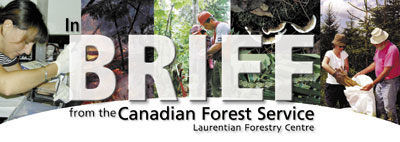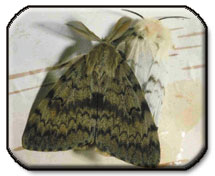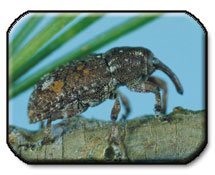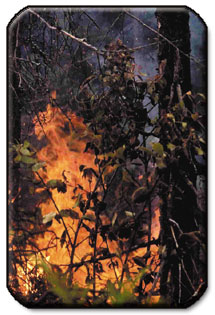
June 2003
 Forecasting
the quality of black spruce wood Forecasting
the quality of black spruce wood
With increased
yield, rotations will become shorter and the use of genetically
improved trees will increase. Trees will grow more quickly and will
be larger. So how will this affect wood quality?
One factor used for measuring wood quality is density.
Canadian Forest Service researchers, along with Université
Laval and Forintek colleagues, conducted a study on predicting the
density of black spruce wood according to growth rings.
Their research showed that the characteristics of
a group of 12 growth rings on a tree could help forecast the wood’s
density when the tree became older.
This will significantly reduce the time it takes
to develop genetically improved trees and will thereby reduce the
associated costs.
For information:
 Forecasting
the population dynamics of the gypsy moth Forecasting
the population dynamics of the gypsy moth
A model that would
simulate the development of a generation of insects could be useful
in assessing the persistence of a given population when it colonizes
a new area.
 Therefore,
Canadian Forest Service researchers looked at ways of modeling the
seasonality of the gypsy moth (Lymantria dispar), an insect
known for attacking deciduous trees and whose population seems to
be growing in Canada. In conducting this research, they were able
to verify the effectiveness of three existing models for egg development
and compared these results with their observations on the hatching
rate of caged egg masses in Victoria, British Columbia. Therefore,
Canadian Forest Service researchers looked at ways of modeling the
seasonality of the gypsy moth (Lymantria dispar), an insect
known for attacking deciduous trees and whose population seems to
be growing in Canada. In conducting this research, they were able
to verify the effectiveness of three existing models for egg development
and compared these results with their observations on the hatching
rate of caged egg masses in Victoria, British Columbia.
The results of two of the models tested were
in line with field observations. When these hatching models were
used in conjunction with larva, pupa and adult development models,
researchers were able to simulate the seasonality of a whole generation
of gypsy moths. Used simultaneously, these models helped to predict
the seasonal occurrence of all stages of the insect’s life
cycle. They proved to be useful decision-support tools for controlling
this insect when it moves into a new area.
For information:
 Death
is part of a tree's life cycle Death
is part of a tree's life cycle
The mortality
rate inforest stands can be more or less severe, and the causes
of death may vary. Usually, mortality in forest stands is divided
into three phases, one of which is a result of competition among
trees, which can be described as a self-thinning process of the
stand. However, studies on this phenomenon appear contradictory,
at least with regard to black spruce. In addition, recent studies
have found a new mortality factor in this species, which had been
overlooked until now: spruce budworm outbreaks.
To add to the information available on this matter,
a Canadian Forest Service researcher, in collaboration with some
colleagues at the Université du Québec à Chicoutimi,
outlined the mortality pattern of 14 black spruce stands located
in the Saguenay region and originating from forest fires and clearcuts
performed at the beginning of the 20th century, and attempted to
explain the mortality patterns observed taking into account various
factors, including the age of the stand, competition, and recent
spruce budworm outbreaks.
The team found that most trees had died in the
1970s and 1980s, which would suggest that the most recent spruce
budworm outbreak is linked to the mortality rate. Their hypothesis
was corroborated by significant growth decreases during the outbreak
periods. The team believes that, given a partial correlation between
mortality rates and the relative density of the studied stands,
competition among stems may be a "predisposing" factor,
while defoliation resulting from spruce budworm outbreaks may be
a "triggering" factor to tree mortality, which mostly
occurred among the smallest stems in the stand.
For information:
 How
to determine which trees are resistant to
the white pine weevil How
to determine which trees are resistant to
the white pine weevil
As early as 1930,
researchers have observed that some Sitka spruce, the tallest conifer
in Canada, could withstand white pine weevil attacks. This insect
is well known in Quebec because of the damage it causes to loblolly
pine and Norway spruce.
As a result of these observations, researchers identified
lineages of resistant Sitka spruce. They then began producing selected
trees as part of a major resistant tree selection program for organized
by the British Columbia Ministry of Forests.
 Canadian
Forest Service researchers participate in the program by developing
quick methods for identifying resistant trees. Canadian
Forest Service researchers participate in the program by developing
quick methods for identifying resistant trees.
One of the methods developed consists in placing resistant
and non-resistant spruce seedlings in cages with weevils. They found
that weevils were less likely to attack the resistant trees than
the non-resistant trees.
This method makes it possible to identify resistant
trees more quickly and thus better determine resistance factors.
For information:
 DNA
persistence: Only a few months DNA
persistence: Only a few months
As is the case
with all transgenic plants, the production of genetically modified
forest tree species raises questions among ecologists and the general
public, as well as among researchers. Increasingly, we seek to assess
potential environmental risks by conducting field trials with these
transgenic species.
A group of Canadian Forest Service researchers has
conducted studies in this vein. Through field tests, they wanted
to find out what would happen to the DNA of the genetically modified
species. According to their research, there is a small risk that
the DNA be absorbed by microbes in the soil, particularly during
decomposition of the leaves and roots. They therefore studied the
persistence of DNA using a marker gene in the decomposing foliar
tissue from transgenic poplar. They put leaves in permeable bags
on the surrounding vegetation on and in the soil.
The study revealed that the DNA with a marker
gene persisted no longer than four months in the forest environment
and that it degraded more quickly in the soil than on the soil as
a result of the relative humidity and the microbial activity of
the soil. The researchers were thus able to show that, as a result
of the rapid degradation of foliar tissue and based on data taken
from other transgenic plant studies, there is little to no risk
that the DNA of genetically modified trees be absorbed by soil micro-organisms.
For information:
 Forest
fires: A 235-year history Forest
fires: A 235-year history
A Canadian Forest
Service researcher, along with colleagues at the Université
du Québec à Montréal, studied forest fires
in eastern Canada from 1760 to 1999 in order to characterize the
recurrence of fires in a 650,000 ha area, of which 510,000 ha are
used for forest management and 140,000 ha are used for agriculture.
 Using
aerial photographs and dendrochronology, researchers were able to
determine that, from 1760 to 1853, fires in both areas were rare,
but that large segments had burned. This is why close to 50% of
the stands still existing were a result of fires prior to 1854. Using
aerial photographs and dendrochronology, researchers were able to
determine that, from 1760 to 1853, fires in both areas were rare,
but that large segments had burned. This is why close to 50% of
the stands still existing were a result of fires prior to 1854.
From 1854 to 1916, the area of the forest fires
decreased: less than 5% of the area was affected by fire during
this period. Researchers explained that the decrease was a result
of a more humid climate, making it less susceptible to major fires.
However, in the agricultural area (developed beginning in 1916),
the number of fires increased as a result of human activities, but
also because more fires were being detected. Despite the increase,
the areas burned continue to decrease in both areas.
For information:
|